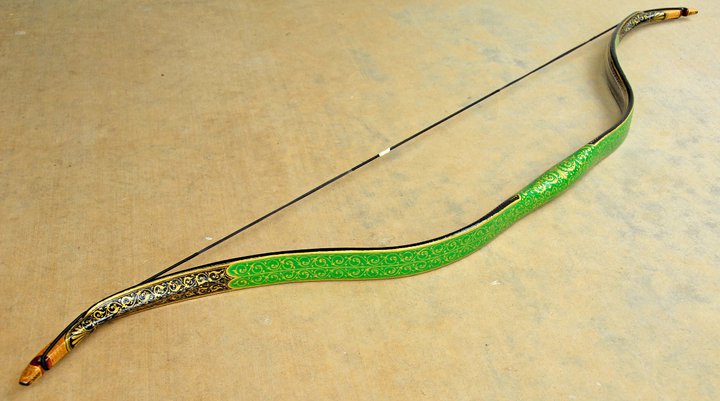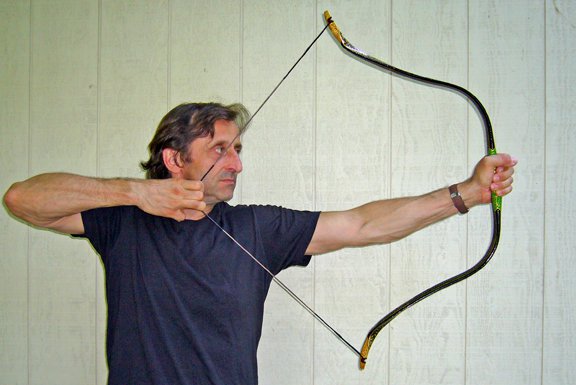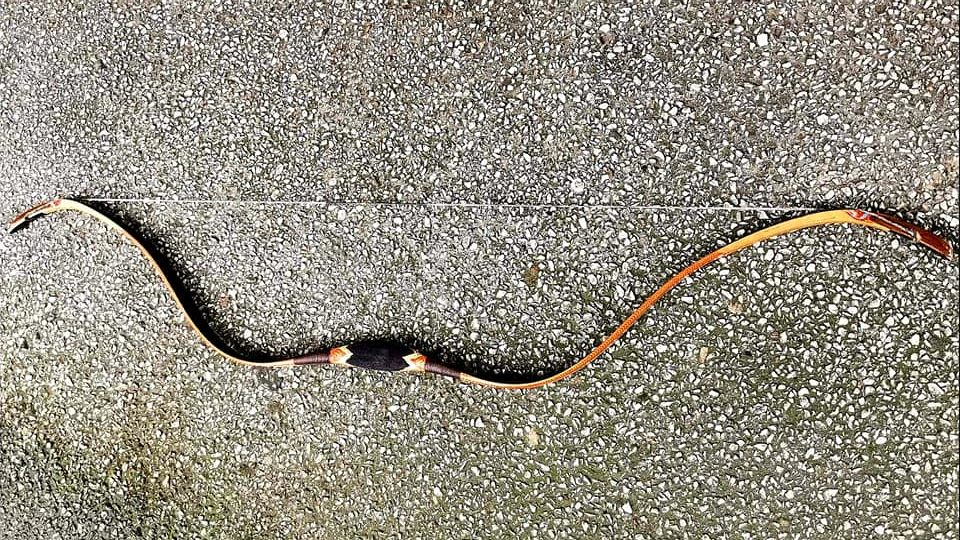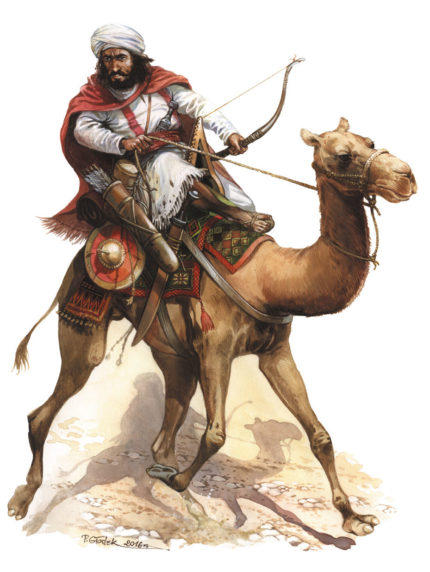Saracen Archery
Saracen Archery – The Bow & The Near East
The ways of the bow and arrow were known in the near east for millennia. Saracen archery would produce some of the most sophisticated and beautiful bows of all. Much like the Turks, they were well known for their composite reflex bows, which they used with great skill and effectiveness on horseback.
What makes Saracen archery quite interesting to study, as it relates to the history of archery, is the fact that several thoroughly detailed texts were written about archery during the medieval period. In this article, we will examine aspects of these texts as well as some unique aspects of Saracen archery.

The Word “Saracen”
The word Saracen was used by Christian writers in Europe to refer to Arab Muslims during the medieval period. Latin and Greek writers used the term in reference to people inhabiting the Roman provinces in the middle-east. The term evolved over the centuries and eventually, the term had become synonymous with “Muslim”.
After the age of discovery (15-17th centuries), the term became used less and less and is now an antiquated, rarely used word.
Saracen Archery – Techniques & Methods
The Saracen archery technique is very similar to that employed by the Turks and the Mongols. All of these people fought primarily on horseback with composite bows. A thumb draw was utilized as well as thumb rings for the protection of that most favorite digit.
The techniques and methods involved in Saracen archery have been documented in great detail in several archery manuals during the medieval period. Most notable amongst these documents is “Saracen Archery” written sometime in the 14th or 15th centuries by a Mamluk soldier, Taybugha Al-Ashrafi Al-Baklamishi Al-Yunani.
The second work by an unknown author was also likely written around the 15th century and has been translated and titled in English as “Arab Archery”. We will further discuss these works in a following section.

One thing that can be said certainly about these manuals is that they go into great detail with regards to describing all aspects of Saracen archery, including of course the techniques used.
To give you a feel for the detail and thoroughness that archery is described in these works, here are some of the titles of chapters/sections of the manual “Arab Archery”:
- ON PICKING UP THE BOW AND ARROW PREPARATORY TO SHOOTING AND THE MANNER OF SHOOTING
- ON THE DIFFERENT DRAWS AND THE MANNER OF LOCKING THE THUMB AND INDEX FINGER ON THE STRING, AND ON THE RULES OF ARRANGING THE INDEX FINGER UPON THE THUMB
- ON HOW TO HOLD THE GRIP OF THE BOW WITH THE LEFT HAND
- ON THE CLENCH
- ON DRAWING AND ITS LIMITS
- ON AIMING, WHICH IS THE SAME AS POINTING AT THE TARGET
- ON THE LOOSE OR RELEASE
- ON THE PASSAGE OF THE ARROW OVER THE LEFT HAND
- ON BLISTERS AND WOUNDS ON THE INDEX FINGER OF THE RIGHT HAND CAUSED BY STRINGING, CLENCHING, DRAWING AND LOOSING, TOGETHER WITH THE REMEDIES THEREOF
The Saracen Bow
In the work “Arab Archery” the author describes several types of bows. These include self-bows (bows made from a single stave of wood), bows that are sinew and horn reinforced, and the murakkabah (put together), which is the true composite bow. These murakkabah bows are made like all traditional composite reflex bows, with wood, horn, sinew, and glue.
The Saracen bow that is the most interesting for our study and the one held in the highest esteem by the expert archers of the day is the murakkabah or composite bow. The author of Arab Archery describes this bow in the following way:
“The composite bow is of elaborate make and careful workmanship. Its construction parallels the make-up of living things. Just as man is made of four component parts (bone, flesh, arteries, and blood) so is the bow made of four component parts. The wood in the bow corresponds to the skeleton in man, the horn the flesh, the sinews to the arteries, and the glue to the blood. Similarly, a human being has a belly and a back, and so has a bow. And just as a man can bend inward upon his belly without any harm, but maybe injured if he bends outward upon his back, so it is with a bow. It can be bent inward upon its belly but will break if it is bent upon its back.”
– Arab Archery, Princeton University Press 1945

As far as the Saracen bow’s original shape, it was made in a similar manner to Turkish and Persian bows of the day. When classifying the different types of bows familiar to the author of Arab Archery, he states that “the third variety of hand bows – the Persian and Turkish – are made in the same way as the Arab composite bow. They have, however, long siyahs and short arms, the siyash and arms being almost, if not quite, equal to each other in size.”
Several modern bowyers have reconstructed the Saracen bow for your shooting pleasure. They are especially beautiful specimens and are held in high regard by many archers to this day. Check out the examples below from some selected bow makers.
THE SARACEN BY SALUKI BOWS

Saracen by Nawalny Bows


Saracen Archery in History
The Saracen bow was used for a long time for hunting and warfare in Arabia and other regions in the middle east. Along with archery, Arabian horses and the equestrian martial art known as Furūsiyya were maximized to great effect in military confrontations. Notable amongst these military confrontations is the Battle of Hattin, fought on July 4th, 1187 between the Crusaders and the Sultan Saladin.
The vast majority of the Crusader forces were captured or killed by Saladin’s forces which consisted mostly of light cavalry archers. Saladin personally led one of the three divisions in his army, which consisted primarily of his own personal elite bodyguards the Mamluks. Captured or purchased as slaves and trained since early childhood, the Mamluks were a formidable opponent. They were trained primarily as mounted units, with a specialty in mounted archery.

The Mulsim warriors managed to constantly harass the Frankish armies as they were on the move to relieve Tiberias which was besieged by Saladin. The Sultan’s forces were able to be resupplied with fresh arrows, and other supplies, most notably water, whereas the Crusaders were running low. As you may also be aware, the middle-east is mostly a dry and arid place, and water running low would have been a major cause of concern.
To make matters worse for the Crusaders, Saladin had ordered his men to set fire to the vegetation close to the Frankish camp, with the smoke and additional heat surely agitating the already thirsty Franks.
Apparently, each Saracen archer was by this time supplied with hundreds of arrows, and the order was given to lose them upon the enemy. As quoted by The 12th-century CE historian Imad ad-Din al-Isfahani recorded, “the arrows plunged into them, transforming their lions into hedgehogs”.
Saracen Archery in Literature
As previously stated, two of the fundamental texts related to Saracen Archery are “Saracen Archery” written by a Taybugha Al-Ashrafi Al-Baklamishi Al-Yunani around the 14th or 15th centuries. It was originally titled in Arabic. Roughly translated, the title reads: “Essential Archery for Beginners”. The translated work is based on a manuscript in the British Museum, shelfmark Add. 23489. Not much is known about the author, other than that he was a Mamluk, and clearly an expert in the field of archery.
The work is available as PDF here: SARACEN ARCHERY
You may also want to check out the actual hardcover. It is rare and no longer in print so it is not as cheap as other more readily available books. A true collector would surely desire such a book for their personal library. CLICK THE IMAGE BELOW FOR MORE!
The second work is title “Arab Archery” and it too was translated from a late medieval Arabic manuscript on archery. Not much is known about the author, not even his name. It could be deduced however, that he was a North African from Morocco, and an expert bowman. The detail and thoroughness of the work are impressive. It could be used as a textbook on archery to this day. This one is readily available at a decent price on amazon here:

Saracen Archery, The Prophet & Islam
Indeed the Prophet of what would later become the religion of Islam was found of archery and was himself a decent shot by all accounts. there are several comments by Muhammad concerning archery in the Hadith.
The Umayyad governor and companion of the Prophet Uqbah ibn Amir, remarked that archery was more dear to him than riding.
The author of Arab archery, in his introduction also states that the Prophet also said: “The hand of man has wielded no weapon which was not excelled by the bow.”
